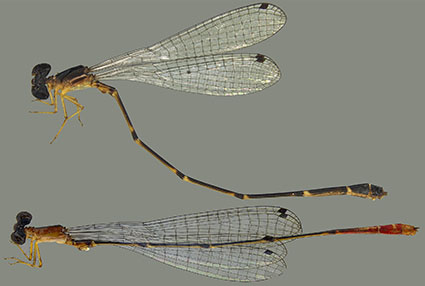Abstract
Psaironeura jeronimoi sp. nov. is described based on seven males (Holotype: ♂ (LABECO, N° 10002717), BRAZIL, Amazonas, Alto Maués Ecological Station, (-5.9852, -59.3182, 114 m asl, 12.v.2019) collected in the state of Amazonas (near Alto Maués Ecological Station) and Pará (municipality of Belterra). This new species fits into the tenuissima group but presents differences in color pattern and shape of the apex cerci. Main morphological characters are figured and compared with those of P. tenuissima (Selys, 1886) and P. bifurcata (Sjöstedt, 1918). Key to males and comments on genital ligula of the species of the group are provided. Finally, comments on the conservation status of the species are presented.
References
Cala-Riquelme, F. (2021) Autodesk Sketchbook: An application that minimizes time and maximizes results of taxonomic drawing. Zootaxa, 4963 (3), 577−586.
https://doi.org/10.11646/zootaxa.4963.3.10
De Marmels, J. (1989) Odonata or dragonflies from Cerro de la Neblina: And the Adjacent Lowland Between the Rio Baria, the Casiquiare and the Rio Negro (Venezuela). Academia de las Ciencias Físicas, Matemáticas y Naturales y Fundación para el Desarollo de las Ciencias Físicas, Matemáticas y Naturales, 25, 1−78.
Garrison, R.W. (2004) An analysis of the Psaironeura tenuissima complex, including synonymy of P. machadoi De Marmels with P. bifurcata (Sjöstedt) (Zygoptera: Protoneuridae). Odonatologica, 33 (1), 83–89.
Garrison, R.W., von Ellenrieder, N. & Louton, J.A. (2010) Damselfly genera of the New World. An illustrated and annotated key to the Zygoptera. The Johns Hopkins University Press, Baltimore, xiv + 490 pp.
Guillermo-Ferreira, R., Vilela, D.S., Cordero Rivera, A., Sandoval-H, J. & Bota-Sierra, C.A. (2021) Psaironeura tenuissima. The IUCN Red List of Threatened Species, 2021, e.T49254712A49256721.
https://doi.org/10.2305/IUCN.UK.2021-1.RLTS.T49254712A49256721.en
Leonard, J.W. (1977) A revisionary study of the genus Acanthagrion (Odonata: Zygoptera). Miscellaneous Publications, Museum of Zoology, University of Michigan, 153, 1–173.
Machado, A.B.M. (1985) Studies on neotropical Protoneuridae. 4. Notes on some Selysian types of Protoneura (Zygoptera). Odonatologica, 14 (3), 211−217.
Pessacq, P. (2008) Phylogeny of Neotropical Protoneuridae (Odonata: Zygoptera) and a preliminary study of their relationship with related families. Systematic Entomology, 33 (3), 511−528.
https://doi.org/10.1111/j.1365-3113.2007.00414.x
QGIS Development Team (2022) QGIS Geographic Information System. Open Source Geospatial Foundation Project. Available from: http://www.qgis.org (accessed 4 October 2022)
Riek, E.F. & Kukalovà-Peck, J. (1984) A new interpretation of dragonfly wing venation based upon Early Upper Carboniferous fossils from Argentina (Insecta: Odonatoidea) and basic character states in pterygote wings. Canadian Journal of Zoology, 62 (6), 1150–1166.
https://doi.org/10.1139/z84-166
Tennessen, K. (2016) Psaironeura angeloi, a new species of damselfly (Zygoptera: Coenagrionidae) from Central and South America. Zootaxa, 4078 (1), 28–37.
https://doi.org/10.11646/zootaxa.4078.1.5
Vilela, D.S. & Guillermo-Ferreira, R. (2020) Psaironeura bifurcata. The IUCN Red List of Threatened Species, 2020, e.T120038027A120039393.
https://doi.org/10.2305/IUCN.UK.2020-2.RLTS.T120038027A120039393.en


